Since 2011, people have undergone more than a half-million cryotherapy sessions around the world.
Within the alternative healthcare realm, many are looking to cryotherapy to treat injuries, speed recovery, and boost athletic performance.
If you haven’t heard of cryotherapy, keep reading to learn more about the amazing benefits of this treatment option.
Cryotherapy has been around for a long time; the use of very cold temperatures as a therapeutic regimen is currently gaining more attention, and even has professional athletes turning to this technique.
 |
| Benefits of Cryotherapy |
Our guide will help you learn more about the health and wellness benefits of whole-body cryotherapy, as well as other procedures that use cryogenics.
We will help you understand how this amazing technique can help elevate your mood, enhance healing, and treat many types of problems in your body.
What is Cryotherapy
Whole-body cryotherapy, also called WBC, is being used more and more to reduce inflammation, relieve pain, and promote healing of damaged tissue.
During cryotherapy, your body is exposed to extremely cold air, usually from liquid nitrogen or argon gas.
During a whole-body cryotherapy treatment, your body is immersed in a cold chamber that emits vapors at temperatures ranging from-160℉ to -220℉ (-110℃ to -160 ℃) for usually no more than four minutes at a time (1).
The Cryogenic Chamber
A cryogenic chamber sometimes referred to as a cryosauna, can best be described as a tube enclosure.
You lie down or stand up inside the tube, the lid is closed over your body, and your head is left outside of the tube to keep it at room temperature.
Cold air is pumped into the chamber, or the air is created by forced convection (2).
Most people are naked inside the cryogenic chamber except for underwear, in addition to gloves and socks to protect your vulnerable extremities.
While in the chamber, your session is carefully monitored by the staff at your cryotherapy facility.
If at any time you are uncomfortable or want to end the session, you can simply push the door open, or your cryotherapy staff can also stop the session easily with controls or by manually releasing the door.
Benefits of Cryotherapy
The primary goal for any cryotherapy session is to reduce your tissue temperature (3).
Because your body reacts to all extreme changes in temperature when you reduce your core body temperature, you signal to your autonomic nervous system, which is in charge of automatic or unconscious functions.
This system triggers a rise in your blood pressure, increases your heart rate, and releases norepinephrine, which is a stress hormone and neurotransmitter (4).
When you are very cold, your body automatically reduces blood flow by constricting blood vessels.
Once you exit the cryogenic chamber, your vessels return to normal and expand, and your blood now has more anti-inflammatory proteins than before your session.
This is good news for injured, healing, or inflamed areas in your body.
In tests using athletes, cryotherapy was shown to provide runners with more oxygen, lowering their heart rates and their perceived exertion during exercise (5).
When cryotherapy is used in a localized manner to treat specific injuries, results include a higher pain tolerance and threshold (6).
The scientific literature on cryotherapy includes evidence of improved recovery time from injury, lowered inflammation, and reduced pain in many subjects (7, 8).
While there is limited evidence to support all of the claims touted by cryotherapy proponents, many claims of health benefits have been substantiated by research over time.
The potential benefits of cryotherapy that are most often cited include:
- Lowered levels of inflammation
- Reduced pain
- Reduced muscle soreness
- Enhanced mood
- Improvement in recovery from trauma, impact, and exercise injuries
- Improved energy levels
- Enhanced weight loss and fat burning
- Improvement in symptoms related to diseases such as multiple sclerosis, rheumatoid arthritis, and osteoarthritis
- Decreased symptoms of asthma
- Improvement of libido
While many note anecdotal evidence to substantiate the claims of cryotherapy’s benefits, little scientific evidence exists to support these claims overall.
More research is needed to verify quantitatively and definitively that cryotherapy reduces symptoms such as soreness and pain (9).
Results related to cryotherapy’s ability to improve recovery are similar to those achieved through rest alone.
There are few adverse effects reported from this type of therapy, and many do report improved mood and less fatigue, so while randomized clinical trials have not supported all claims, there is no harm in using cryotherapy.
Below, we elaborate on the health benefits of whole-body cryotherapy according to the latest research, including the anti-inflammatory and pain-relieving ones.
It is worth noting that the Food and Drug Administration (FDA) does not currently regulate any use of cryotherapy.
Understanding the Vocabulary of Cryotherapy
The use of very cold temperatures to destroy cells or to promote circulation can be called many different things.
The term cryotherapy is sometimes confused with other uses of extremely cold temperatures, like cryoablation and cryosurgery.
In cryosurgery, extremely cold gas, usually from liquid nitrogen, is used to destroy unwanted tissue in localized areas of the body.
Cryoablation means the same thing.
These procedures, which are performed by a physician and usually in a medical office or hospital, are used to remove and treat the following:
- Pre-cancerous skin moles, skin tags, or nodules;
- Retinoblastomas, which is a type of cancer on the retina;
- Atrial fibrillation, which is a heart rhythm disorder;
- Tumors found in various areas, including the prostate, breast, liver, cervix, lungs, kidneys, or bones.
Cryosurgery is most commonly used to remove tumors, both inside the body and on the skin.
Not all these tumors are cancerous, but some can be.
If the tumor is on the skin, liquid nitrogen is applied directly to the problem area, using a sprayer or a cotton swab.
This destroys the tissue by freezing it.
When the problem is internal, cryoablation techniques are employed using hollow needles that direct the frozen gas to the tumor or abnormal cells.
After this procedure, the thawed tissue may form a scab, or dissolve away.
The side effects of any of these localized cryo-surgical techniques are usually minimal but can include mild pain, swelling, blisters, light bleeding, redness, and cramps.
In rare cases, hair loss or scarring may occur.
A form of localized cryotherapy can also be used to deaden a nerve that is irritated and causing pain.
To accomplish this, a doctor will insert a probe into the tissue surrounding the affected nerve, and the probe’s temperature is then dropped significantly to freeze this nerve.
Once frozen, the nerve is inactivated, and pain should stop.
This is an effective option for those dealing with nerve pain.
This technique can be used to treat many different conditions that irritate an isolated nerve.
The most common include pinched nerves, also called nerve entrapments, and benign nerve growths called neuromas.
These conditions often create a great deal of pain and uncomfortableness, and cryotherapy has been effective at eliminating this discomfort in many patients.
In contrast, whole-body cryotherapy is not invasive like cryosurgery, nor does it require a physician, as it is not a medical procedure.
This less-invasive and very quick exposure to extremely cold gas yields different results, compared to cryosurgery procedures.
So why would anyone want to try cryotherapy?
Let’s examine its most common and beneficial effects.
The Benefits of Cryotherapy
The beneficial effects of cryotherapy are varied and many.
And as we study this treatment option more, we are learning increasingly about the many ways cryotherapy can benefit your health, and be a treatment for specific problems.
Injury Recovery
The prevention and treatment of muscle pain and soreness is the most common reason people turn to cryotherapy.
We are all aware that cold therapy can provide pain relief after surgery or an injury.
After all, isn’t an ice pack something we all have in our first aid kits?
Cryotherapy is a more intense version of this type of treatment that can be used to treat acute injuries, trauma, or even muscle strain from exercise.
Widely used in sports medicine, both whole-body and localized cryotherapy treatments are commonly suggested for those recovering from an injury.
They can also be used to promote healing after overuse (11).
Because exercise is known to produce inflammation and pain, cryotherapy is also sometimes used as a preventative strategy.
One of the largest reviews of the literature currently available on cryotherapy benefits found that cryotherapy helps reduce pain in 80 percent of studies, and athletes experienced improved recovery and overall performance in 71 percent of studies.
This review also indicated that whole-body cryotherapy has few, if any, side effects, for those using it for these purposes (12).
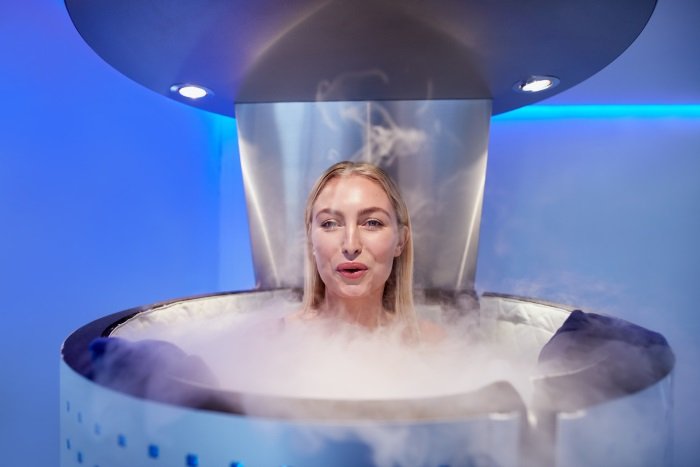
Decreased Inflammation & Tissue Damage
As a part of the same review of the available literature, it was noted that cryotherapy also reduces systemic inflammation, and promotes healthy muscle tissue overall (13).
With multiple exposures, it is believed that cryotherapy can improve recovery time and promote healing.
With repeated treatments, patients saw less pain, improved muscle function, and lower levels of inflammation when compared to those who underwent single treatments.
When inflammation is reduced, you are able to return more quickly to high-intensity physical activity, thus reducing recovery time.
When you have inflammation for a prolonged period, you are more likely to have reduced blood flow, more pain, and less mobility.
Empirical evidence also supports the claims that cryotherapy can reduce inflammation.
A 2010 study stated that cryotherapy conducted on athletes modifies several essential physiological and biochemical parameters related to inflammatory response.
These included changes in the status of antioxidants, fewer muscular enzymes related to muscle damage, and fewer pro-inflammatory cytokines (14).
There are a number of anti-inflammatory proteins that are shown to increase after cryogenic chamber treatment, including cytokines IL-6, IL-10, and IL-1ra, and the pro-inflammatory cytokine IL-1α also decreases with cryotherapy treatment.
When you complete multiple sessions, these results are shown to last longer (15, 16).
By restricting blood flow, cryotherapy is able to reduce exercise-induced inflammation (17).
Other controlled studies have shown a reduction in other pro-inflammatory proteins, such as IL-1β.
In these studies, athletes were given whole-body cryotherapy treatment prior to exercise, and the protein levels were measured after exercise (18).
The evidence to support these claims is not sufficient for some researchers, though.
In 2014, a review of the literature claimed there was insufficient evidence regarding the ability of whole-body cryotherapy to improve recovery time or have a significant impact on antioxidant capacity.
The argument maintained in this review is that cryotherapy does not sufficiently cool the core body temperature to lead to lasting inflammation reduction.
These researchers maintain that using ice packs and other localized treatments are just as effective as whole-body cryotherapy methods (19).
Enhancing Your Mood
When you are inside the cryogenic chamber and the temperature drops suddenly, your body releases mood-lifting endorphins.
These endorphins help you feel more energetic and happier and mimic the natural high you get from exercise.
Because whole-body cryotherapy alleviates pain in some, as well as improves circulation, this could also have an effect on your overall mood and outlook.
After all, when you physically feel better you are more likely to feel better mentally, as well.
More Energy and Less Fatigue
After cryotherapy treatments, many people say they feel energetic and clear-headed.
Most likely, this is caused by the release of endorphins, as well as improved blood flow and lowered inflammation.
After a stressful event, whole-body cryotherapy has been found to improve not only physical but also psychological recovery.
This includes reducing pain, fatigue, and muscle tiredness (20).
Improvement for Rheumatic Diseases
Conditions that cause chronic pain in muscles and joints are known as rheumatic diseases.
The most well-known of these is probably rheumatoid arthritis.
When subjected to cryotherapy, researchers have discovered that patients with rheumatoid arthritis experience a significant reduction in pain, improvement in their mobility, and reduced functional impairment.
This results in overall improved well-being for these patients.
Results have been shown to last as long as three months after cryotherapy ends (21).
When compared to cold pack application and localized cold air treatment, whole-body cryotherapy improved patient symptoms of rheumatoid arthritis significantly more than other types of cold treatment (22).
When compared to traditional rehabilitation, the effects of whole-body cryotherapy have been shown to improve fatigue, inflammation, and pain relief to comparable degrees (23).
Therefore, when a cryotherapy is an option, it can improve patient recovery as well as or better than other methods traditionally used for rehabilitation and the treatment of rheumatoid arthritis.
Cryotherapy can reduce the need for pain medications, improve the mental state of patients in pain, and enhance the overall well-being of patients using this therapeutic technique.
When studied in patients with other types of rheumatic disorders, cryotherapy is equally successful in reducing pain and other negative symptoms.
These benefits include enhanced joint mobility and reduction in pain that lasts up to two months after the final cryotherapy treatment.
Cryotherapy even holds promise for treating rare and debilitating disorders, such as Ankylosing Spondylitis, or AS.
This disease is arthritis of the spine, and it causes severe, chronic pain that can often be hard to live with.
When patients with AS were given treatment in a cryogenic chamber, they showed significantly improved mobility and decreased disease activity overall (24).
As we learn more about whole-body cryotherapy, and its impact on rheumatic diseases and other disorders, cryogenic chambers may be used more frequently as a supplement to other prescribed treatments such as anti-inflammatory drugs and corticosteroids.
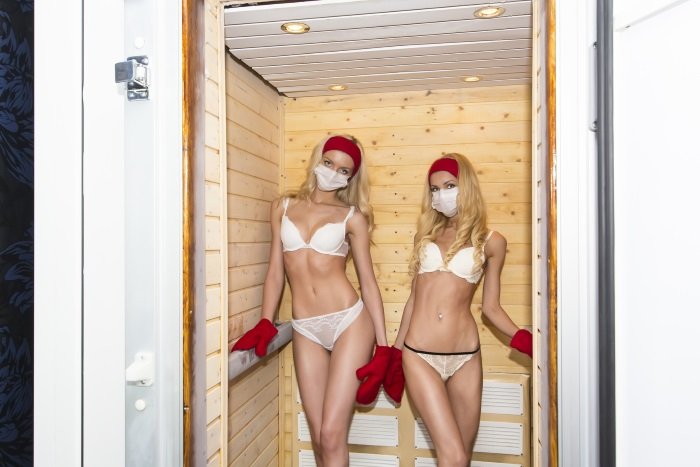
Lowered Oxidative Stress
When patients undergo cryogenic therapy, they show increased levels of antioxidants and reduced indicators for oxidative stress within the body (25).
While there have been mixed results in this area, it does appear that cryotherapy can have some positive impact on certain antioxidants within the body, which in turn can reduce oxidative stress and its impact on all body systems.
There is some evidence to suggest the effect is intensified when cryotherapy occurs after exercise or training (26).
Prevention of Metabolic Diseases
Because of its potential to reduce oxidative stress within the body, plus its ability to lower inflammation, cryotherapy is currently being investigated as a possible treatment for metabolic diseases like Type 2 diabetes.
Because it has a positive influence on inflammation, cryotherapy can essentially mimic the effects of exercise, which is good for those with diabetes.
Studies have shown that both the presence of antioxidants and the levels of oxidative stress were influenced by cryotherapy in some patients, which means it holds promise for use as a treatment for these diseases (27).
Cryotherapy can even help defend against the negative effects of stress, which is an underlying cause of many of today’s diseases.
By supporting the nervous system and promoting the release of norepinephrine, whole-body cryotherapy works in much the same way as exercise and has a positive influence on the cellular functions associated with inflammation.
Cryotherapy, therefore, has promise for treating many diseases that are caused or made worse by stress.
A Decrease in Tinnitus Symptoms
Tinnitus, which is also known as ‘ringing in the ears,’ is usually a symptom of some other medical condition, like an ear injury or loss of hearing.
When exposed to whole-body cryotherapy, patients with tinnitus have shown a decrease in the intensity of the ringing.
In addition, cryotherapy can limit, in some cases, the degree to which hearing is lost or overall hearing damage (28).
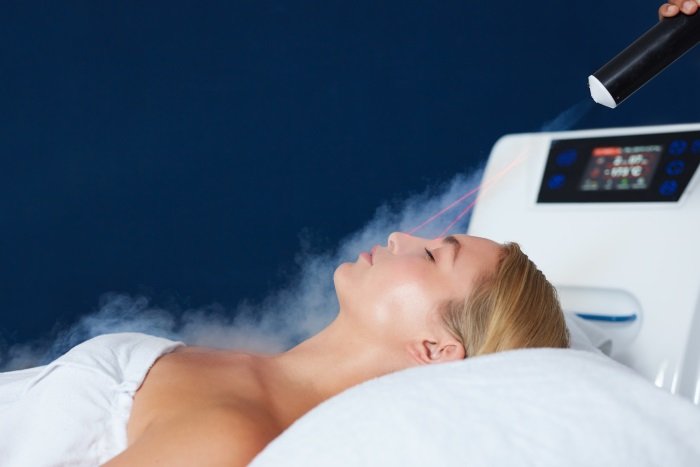
Improvement of Multiple Sclerosis Symptoms
Induced by oxidative stress, multiple sclerosis, or MS, is known for its degeneration of neural networks and nerves by the immune system.
MS has many symptoms, the most common of which include fatigue, weakness in the muscles, painful muscle spasms, numbness, dizziness, and changes in mood.
Because of its connection to oxidative stress, cryotherapy has been studied for its impact on MS symptoms.
Not only does whole-body cryotherapy reduce levels of oxidative stress in patients with MS, but it has also been shown to improve fatigue levels as well as functional status.
In patients who had more fatigue, cryotherapy produced better results (29, 30).
Additional research shows MS patients were able to improve their duration of activity as well as their overall ability to exercise after treatments in the cryogenic chamber.
The results lasted for several months, especially for those with secondary-progressive MS, which gets progressively more debilitating and has little chance of recovery (31).
When considering treatments for diseases like MS, cryogenic therapies could offer significant improvement in the quality of life for patients.
More research is needed in this area to determine the overall impact of whole-body cryotherapy on MS patients.
Improvements in Anxiety and Depression
In addition to treating physical injuries and disorders, cryotherapy is being studied as a way to heal psychological strain and improve mental health disorders such as depression and anxiety.
Preliminary research in this area is promising.
Patients were given regular whole-body cryotherapy treatments for several weeks.
After each session and after all cryotherapy was complete, patients were monitored using the Hamilton Depression Rating Scale.
In nearly all areas, whole-body cryotherapy led to improvements for patients (32).
Not only does this type of treatment reduce patients’ own assessments of their anxiety and depression symptoms, but it also increases their overall satisfaction with life (33, 34).
Chronic pain can often be the cause of or a contributing factor to depressive symptoms.
When studied in patients with spinal pain or other joint issues, cryotherapy has been shown to increase overall well-being and improve patients’ quality of life.
And the more depressed the mental state before therapy, the more powerful the results after it (34).
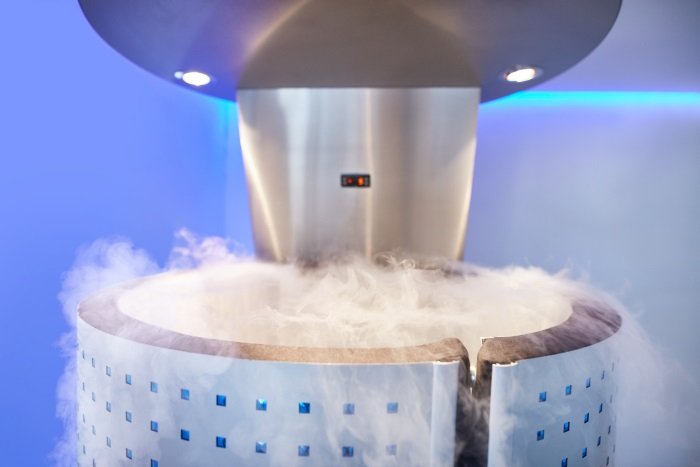
Treatment for Fibromyalgia
If you have fibromyalgia, you are familiar with the increased pain in your bones and muscles, the fatigue, and the difficulty sleeping that are characteristic of this disease.
Patients with fibromyalgia have seen improvements in their symptoms using whole-body cryotherapy.
Patients with fibromyalgia report an improved quality of life when using cryotherapy, compared to those using traditional therapies (35).
Results have even been shown to last for up to one month after the final cryogenic treatment (36).
Helps With Eczema
Eczema, also known as atopic dermatitis, can sometimes be improved using whole-body cryotherapy.
Some patients with eczema have reported improvement, and this is truer for women than for men.
Not all patients enjoyed improved skin appearance and water loss, though.
A small percentage actually stopped treatment, due to worsening of their symptoms (37).
Treatment for Restless Legs Syndrome
Cryotherapy has been tested as a possible treatment for restless legs syndrome, or RLS.
This disorder of the nervous system creates an urge to move your legs, especially while sitting or lying down.
Because it interferes significantly with the ability to sleep, RLS is also considered to be a sleep disorder.
Symptoms of RLS include uncomfortable sensations in the legs, an irresistible urge to move your legs, and feelings of itchiness or pins and needles in your legs.
When patients with RLS were treated with whole-body and localized cryotherapy, and while both therapies improved symptoms, whole-body cryotherapy treatments showed more improvement in symptom reduction and overall quality of life (38).
Improved Heart Health
When examining the impact of whole-body cryotherapy on cardiac activity, cold therapy was seen to have a positive influence on both resting heart rate and cardiac output.
When measuring the amount of blood pumped per beat, otherwise known as stroke volume, and the activity of baroreceptors, which control blood pressure, cryotherapy has both an immediate and a long-term positive effect (39).
Reduction in Headaches
Whole-body cryotherapy often inspires ideas or is inspired by ideas from other areas of medical research.
For example, those with severe migraines often experience relief when cold or ice packs are applied to the neck.
This reduces the expansion of blood vessels and restricts blood flow, which helps alleviate pain.
This is an example of localized cryotherapy, and researchers are examining ways to use whole-body treatments for headaches and other types of pain disorders
Possible Treatment for Dementia
Because of its anti-inflammatory effects and ability to increase antioxidants and lower oxidative stress, it is hoped that, someday, whole-body cryotherapy may be used in the treatment of dementia disorders, such as Alzheimer’s disease.
While this is not a current application of this technology, as we learn more about the effects of cryotherapy, we could be seeing this innovation sometime in the future.
Support for Weight Loss
While there are many claims online and in the media about cryotherapy’s ability to help burn fat and lose weight, there is not a great deal of empirical evidence to support these claims.
While exposure to cold therapy has been shown to boost metabolism, this has not yet led to significant decreases in body fat or weight in most people who have tried this technique.
However, because cryotherapy is known to enhance mood, provide extra energy, and reduce pain, this may keep you more active and able to exercise more which could positively influence your weight loss efforts.
So, while cryotherapy itself is not going to cut body fat, the positive effects of this treatment could help you meet your weight loss goals on your own.
Finding a Cryotherapy Center or Clinic
Most doctors, chiropractors, and physical therapists will be able to refer to you a local cryotherapy center.
If you have friends who have tried cryotherapy, they are also an excellent source for a referral.
Or you can conduct an online search to find a clinic in your area.
Cryotherapy sessions range in price, depending on your location.
A whole-body cryotherapy session can cost as little as $40, and as much as $100.
Sessions are very short, usually lasting less than five minutes.
Always investigate the center before choosing it for any cryotherapy treatments.
You want to ensure the center is properly licensed and run by staff who are knowledgeable and well-trained.
When you call to make an appointment, be sure to ask any questions you may have, and if you are unsure, talk with your physician about the center to see if they have any helpful knowledge.
If you are considering cryosurgery, always consult your dermatologist or physician, as this procedure should be done by a licensed medical professional.
Your treatment goals and condition will dictate the type of surgery you need, and who is the most qualified to perform it.
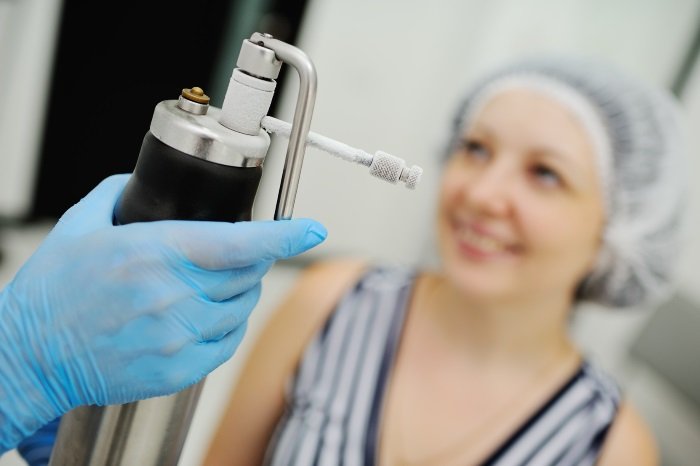
Side Effects of Cryotherapy
Cardiac Complications
The natural side effect of cryotherapy is to increase blood pressure and reduce heart rate.
If you use cryotherapy consistently or repeatedly, this can cause a short-term rise in your blood pressure, even when not in the cryogenic chamber.
If you have a heart condition, have high blood pressure, or take medications for your heart, talk with your doctor about the potential short- and long-term effects of cryotherapy on your heart.
We currently have limited information on the effects of extreme cold, like that used in cryotherapy, on the heart.
For example, one individual experienced a tear in the main artery that pumps blood to the lower half of the body after 15 cryogenic chamber sessions (40).
While this is an isolated case, without further evidence, it is difficult to know the effects of cryogenic temperatures on people with all types of cardiac issues.
Respiratory Complications
Whole-body cryotherapy can cause constriction in the airways, and you should use caution with repeated cryotherapy sessions.
In one study, otherwise healthy young men used whole-body treatments for three months and experienced a noticeable decrease in their respiration rates immediately following treatment; this reaction was more pronounced over time (41).
If you have asthma, COPD, or other respiratory issues, you may want to avoid repeated exposure to cryogenic treatments.
Amnesia
In one case, an individual suffered from transient global amnesia after a whole-body cryotherapy session (42).
While he fully recovered very quickly, this adverse incident helps us recognize how little we actually know about the use of cryotherapy on different people with varied medical conditions.
Additional Precautions
Understanding the risks involved with cryotherapy can help you determine if this type of treatment is best for you.
The majority of studies and reviews of the literature have concluded that there are few adverse effects related to whole-body cryotherapy, but because we lack sufficient data, it is difficult to know for sure.
There have been occasional deaths reported that are linked to cryotherapy.
A small number of reports nationwide have surfaced claiming death or injury from whole-body cryotherapy sessions.
While these cases may not all be directly attributable to cryotherapy, it is important to know the facts regarding this form of treatment.
There are certain medical conditions that may make whole-body cryotherapy unsafe.
If you suffer from any of the following medical disorders or diseases, you should not use cryotherapy treatments for any reason.
These contraindications include arrhythmia, a circulatory disorder, uncontrolled hypertension, Raynaud’s phenomenon (sometimes called white fingers), allergies to cold, a serious coronary disease, a serious pulmonary disease, or if you have a cold that is obstructing your ability to breathe.
Precautions
Cryotherapy involves exposing your body to extremely cold air.
This type of therapeutic treatment is used for a variety of purposes, including decreasing inflammation, destroying unwanted cells, improving your circulation, and promoting healing.
Whole-body cryotherapy treatments take place in a tube that encloses your whole body except for your head.
In short sessions, usually less than five minutes, your body is exposed to a gas that has been cooled to extremely low temperatures.
There is mixed evidence to support the use of cryotherapy for specific medical problems, but many people who try this treatment report positive results.
The most commonly-reported positive side effects include enhanced mood, reduced levels of pain and soreness, and faster recovery after exercising.
Other reported but not thoroughly studied results of cryotherapy treatments include help with tinnitus, multiple sclerosis, diseases caused by oxidative stress, rheumatic disorders, headaches, mental health problems, metabolic diseases, fibromyalgia, eczema, restless legs syndrome, fatigue, and even dementia.
More research is needed to understand fully the effects of cryogenic chambers and cryotherapy on various disorders and diseases.
The literature on this treatment method is not robust and is oftentimes contradictory, so more clinical, empirical research is needed on the impact of cryotherapy on the human body over time.
In general, cryotherapy is extremely safe.
In very rare instances, people have suffered from burns or frostbite, and even death has occurred.

0Comments